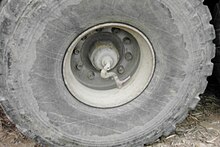Bulldozing effect
Bulldozing effect refers to the wedge created in front of a tire, which is created when driving on soft ground and thereby increases the overall wheel resistance, which means that more force has to be used to move the vehicle in this direction.
The development of the bulldozing effect is inversely related to the air pressure in pneumatic tires (internal tire pressure). When driving on plastically deformable road surfaces (e.g. sand, meadow, earth, snow, etc.), a low air pressure in the tire means that the vehicle tire has a larger contact surface and can penetrate less deeply into the ground ( ruts ), which means that the The resulting wedge in front of the tire becomes smaller and the performance of the vehicle can be better used with mostly reduced fuel consumption. Example: the diesel fuel consumption of a tractor increases per centimeter of track depth due to the forced tire deformation and the bulldozing effect by approx. 10%.
Deep ruts in field work also lead to undesirable soil compaction, can increase tire slip and lead to the vehicle or machine getting caught.
Since, above all, many vehicles and machines from agricultural engineering and in the military sector are operated with pneumatic tires both on paved roads and off-road, the advantages of the higher internal tire pressure when driving on the road must be balanced out in relation to the disadvantages when driving off-road. This can be done, for example, by an automatic tire pressure control system. This eliminates the need to manually adjust the tire pressure, as the pressure of the tires between field use and road travel can be regulated from inside the vehicle with an automatic system.
Resistance calculation
In practice, the resistance caused by plastically deformable roadways largely only plays a role when driving off-road on unpaved roads. The deformation resistance of the ground is the central component and can be more than 15% of the vehicle's weight on soft ground. The wheel resistance F R pl can have 10 to 100 times the actual rolling resistance. This additional wheel resistance force F R pl results essentially from the three components:
- Compression resistance (F R pl dense ),
- Displacement or "bulldozing" resistance (F R pl Bull ) and the
- Side wall friction in the track groove (F R pl track )
This results in a simplified formula: F R pl = F R pl dense + F R pl Bull + F R pl track
Web links
Individual evidence
- ↑ a b Ludwig Volk, Stephan Denker and Sandra Rose: Possibilities for increasing diesel efficiency in agriculture , Volume 66, 2/2011, Landtechnik , magazine of the Kuratorium für Technik und Bauwesen in der Landwirtschaft e. V. (KTBL), pp. 140 ff. ( Online ).
- ↑ Bernd Heißing (ed.): Chassis Handbook , Wiesbaden, 2013, Springer specialized media, p.44 f. ISBN 978-3-658-01992-1 .


